While working with disks on Windows 10 or 11, you may occasionally encounter error messages that prevent successful drive access. A frequent and often confusing message is “The parameter is incorrect.”
Error: The Parameter Is Incorrect on Windows 11/10
The “incorrect parameter” error frequently occurs when an internal or external drive becomes inaccessible. In most cases, this happens due to file system corruption, bad sectors, or damage to the disk’s data structures.

Since the drive is inaccessible, attempting to repair it may cause further damage and result in permanent data loss. Therefore, securing your data should be the first step before attempting any repairs.
To safely recover files from an inaccessible disk, you need to use a reliable data recovery tool.
Step 1: Recover Data When the Parameter Is Incorrect
MiniTool Power Data Recovery provides powerful capabilities for recovering data from damaged and inaccessible partitions.
It supports not only hard drives, but also SD cards, USB flash drives, external hard drives, optical disks, and other devices.
This tool is capable of restoring almost all file types. The recovery process does not write to the original disk, maximizing data security.
This free data recovery software allows you to recover 1 GB of files for free. Having strong compatibility, it can be used on Windows 11/10/8/8.1. Download and install it now!
MiniTool Power Data Recovery FreeClick to Download100%Clean & Safe
Step 1: Scan the inaccessible disk
Open MiniTool Power Data Recovery. After loading all the disk information, you will enter the main interface. Under Logical Drives, find the target drive, move your cursor to it, and click Scan.
Alternatively, you can switch to the Devices tab, which includes all the disks connected to your computer, to scan the entire physical disk.

Step 2: Find the target files using Path, Type, Filter, and Search
When the scan process ends, all the files will be listed under Path based on their file structure. To restore multiple files at once while keeping their original organization, select the desired folders for batch recovery.
Besides this, MiniTool provides three file locating features: Type, Filter, and Search. They can help you quickly find target files within massive scan results.
- The Type feature automatically categorizes scanned files by type, such as documents, images, audio, videos, and compressed files. Switch to Type and you can quickly browse a certain type of file.
- The Filter feature allows you to filter files by file type, modification date, file size, and file category, further narrowing your search. Click the Filter button and set the criteria.
- The Search feature is the most direct way to locate files. Enter a file name or keyword and press Enter. The specific file will be filtered.

Step 3: Preview the files you want before recovery
After locating the target file, use the Preview feature to view the file contents. This confirms whether it is the file you want to recover, avoiding recovering useless data.
Double-click the files one by one. If the format supports preview, the software will pop up a preview window to display the specific contents.
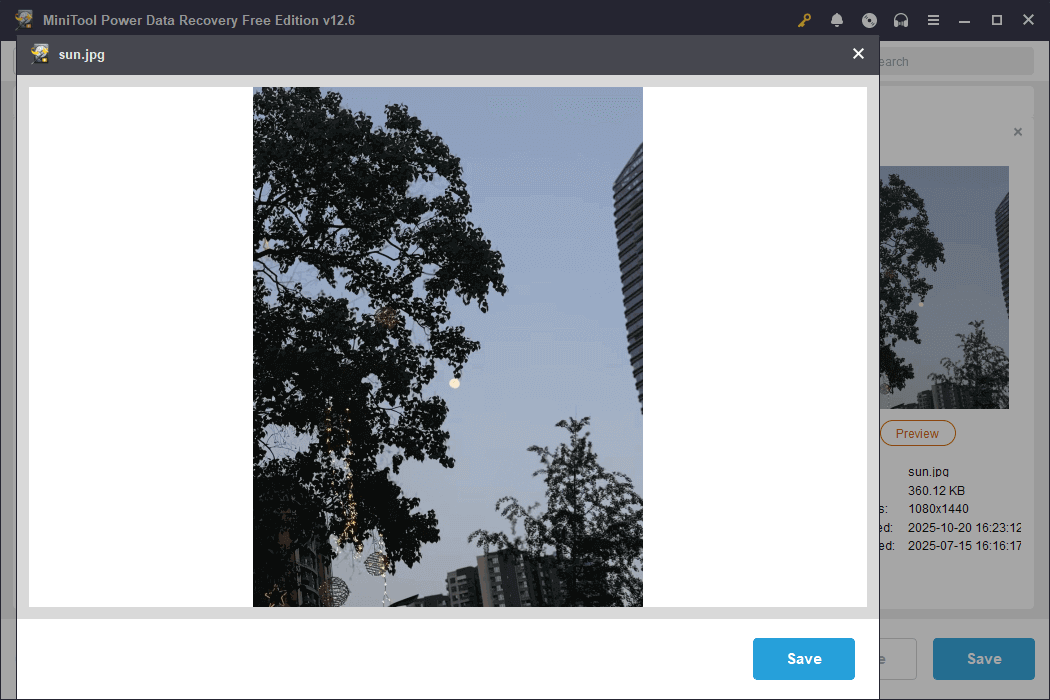
Step 4: Recover the files you ticked to a safe location
After confirming all the needed files, tick them all and click the Save button. There will be a pop-up window prompting you to choose a path for the recovered files. Choose a safe location and click OK. The recovery will start.
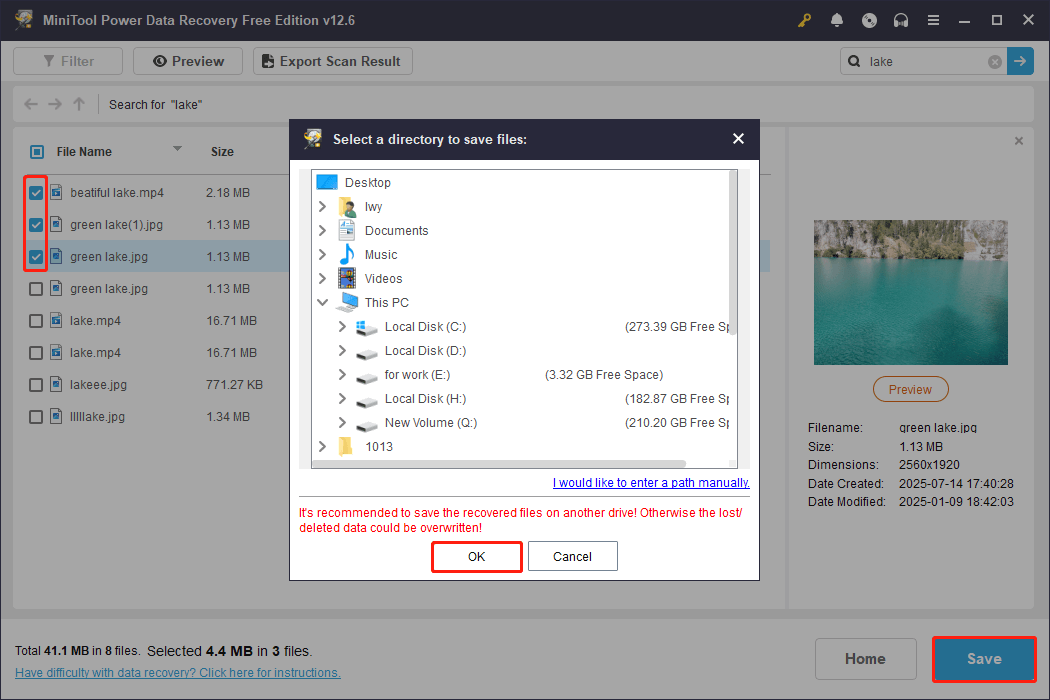
If you find that your free recovery capacity has been used up, consider upgrading to a full edition.
Step 2: Fix the Error of “The Parameter Is Incorrect”
After ensuring data security, you can perform disk repair. The following effective methods can help you fix “The parameter is incorrect”.
Fix 1: Check the Interface and Data Cable
When a disk is inaccessible and displays a “parameter error” message, first connect the disk to a USB port on the back of the computer to rule out power supply or signal instability.
Next, try replacing the data cable or adapter to avoid transmission abnormalities caused by aging or poor-quality cables.
Finally, test the disk on other devices to confirm whether the problem is with the interface or hardware.
If the problem isn’t solved, check the advanced ways.
Fix 2: Run CHKDSK
CHKDSK (Check Disk) is a built-in disk inspection and repair tool on Windows. It scans and attempts to repair file system errors and other disk-related issues. Here is how to run CHKDSK.
Step 1: Open Command Prompt as an administrator
Type cmd in the Windows search bar, right-click Command Prompt, and choose Run as administrator.
Step 2: Execute the command
Input chkdsk /f /r /x G: in the window and press Enter. Replace G with the drive letter of your drive.
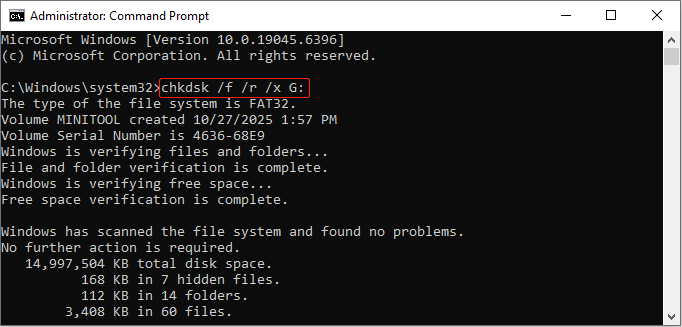
This scan and repair process will take some time. Wait patiently for it to complete. When it ends, check your disk. If the error persists, try the following methods.
Fix 3: Update or Reinstall Disk Drivers
Outdated or incompatible disk drivers may also lead to the parameter error. At this time, it is best to update or reinstall the disk driver.
Step 1: Access Device Manager
Right-click the Windows button and choose Device Manager.
Step 2: Update the disk driver
Expand Disk drives, right-click your disk, and choose Update driver. In the new window, select Search automatically for drivers.
This process will automatically detect new drivers. After finding an available one, follow the on-screen instructions to complete the installation.
What if the problem is not solved after updating the driver? Try reinstalling it according to the following steps.
Step 1: Open Device Manager and expand Disk drives.
Step 2: Right-click the disk and choose Uninstall device.
Step 3: Hit Uninstall again to confirm the change.
When the uninstallation is finished, restart your computer, and Windows will automatically install the new driver.
What to do if the error still exists? Don’t panic. Keep trying the methods below.
Fix 4: Run an SFC Scan
Abnormal system files may cause parameters to not be correctly recognized or processed, resulting in a parameter error. Running SFC can check and repair damaged or missing system files.
Step 1: Open an administrative Command Prompt
Press Win + S and enter cmd. Right-click Command Prompt and select Run as administrator.
Step 2: Run the SFC scan command
In the Command Prompt window that opens, enter sfc /scannow and press Enter. It will begin scanning all protected system files and automatically repair corrupted files.
Wait for the scan to complete. After it is complete, check your hard drive. If this method doesn’t work, there are other options.
Fix 5: Scan for Viruses
In rare cases, the parameter error may also be triggered by malware infection, so performing a quick virus scan is advisable for safety.
Here is how to run a virus scan by using Windows Defender:
Step 1: Open Settings and Windows Security
Press Win + I to open the Settings app. Click Update & Security > Windows Security.
Step 2: Access the scan option page
Click Virus & threat protection under Protection areas. Then, hit Scan options under Current threats.
Step 3: Start a virus scan
Choose a scan type between Quick scan, Full scan, Custom scan, and Microsoft Defender Offline scan according to your needs. After confirming that, click Scan now and wait for the process to complete.
If you still receive this error message, try uninstalling antivirus software.
Fix 6: Uninstall Antivirus Software
Some antivirus programs may block disk access or interfere with parameter passing. This can prevent the system from correctly interpreting the required parameters, resulting in a parameter error.
Uninstalling the antivirus software can eliminate interference and verify whether it is the cause of the error. Here is how to uninstall antivirus software.
Step 1: Press Win + S, type the software name, right-click the best match, and choose Uninstall.
Step 2: In the Programs and Features page, right-click the software and choose Uninstall.
Step 3: In the pop-up window, click Yes. Wait for the process to complete.
If all the above methods fail, the last one definitely won’t let you down.
Fix 7: Format Your Problematic Drive
Formatting can be your last resort. This operation can rebuild the file system and clear potential faults, restoring normal use of the disk. Here are two options you can refer to.
Option 1: Format the disk in Disk Management
Disk Management is a built-in Windows utility for managing disks. It can format a disk to clear damaged structures and re-establish a new file system. This restores the disk to normal use.
Here is how to format your disk in Disk Management:
Step 1: Press Win + X and choose Disk Management.
Step 2: Right-click the disk and choose Format.
Step 3: Set the volume label and file system, and make sure the box for Perform a quick format is checked.
Step 4: Click OK and OK again to apply the change.

Option 2: Format the drive with MiniTool Partition Wizard
MiniTool Partition Wizard boasts enhanced partition repair and formatting capabilities. It can rebuild damaged file system structures to restore disk usability.
Compared to Windows’ Disk Management, this tool offers a more intuitive interface and more powerful disk management capabilities, making it suitable for users who require advanced disk operations.
Here is how to format the disk using MiniTool Partition Wizard:
Step 1: Download and install MiniTool Partition Wizard by clicking the following button.
MiniTool Partition Wizard FreeClick to Download100%Clean & Safe
Step 2: Launch the software and select the target drive in the right pane.
Step 3: Click Format Partition under Partition Management.
Step 4: Set the partition label and file system, and click OK.
Step 5: In the lower left corner of the main interface, click Apply.
Step 6: Hit Yes in the pop-up window to perform the operation.
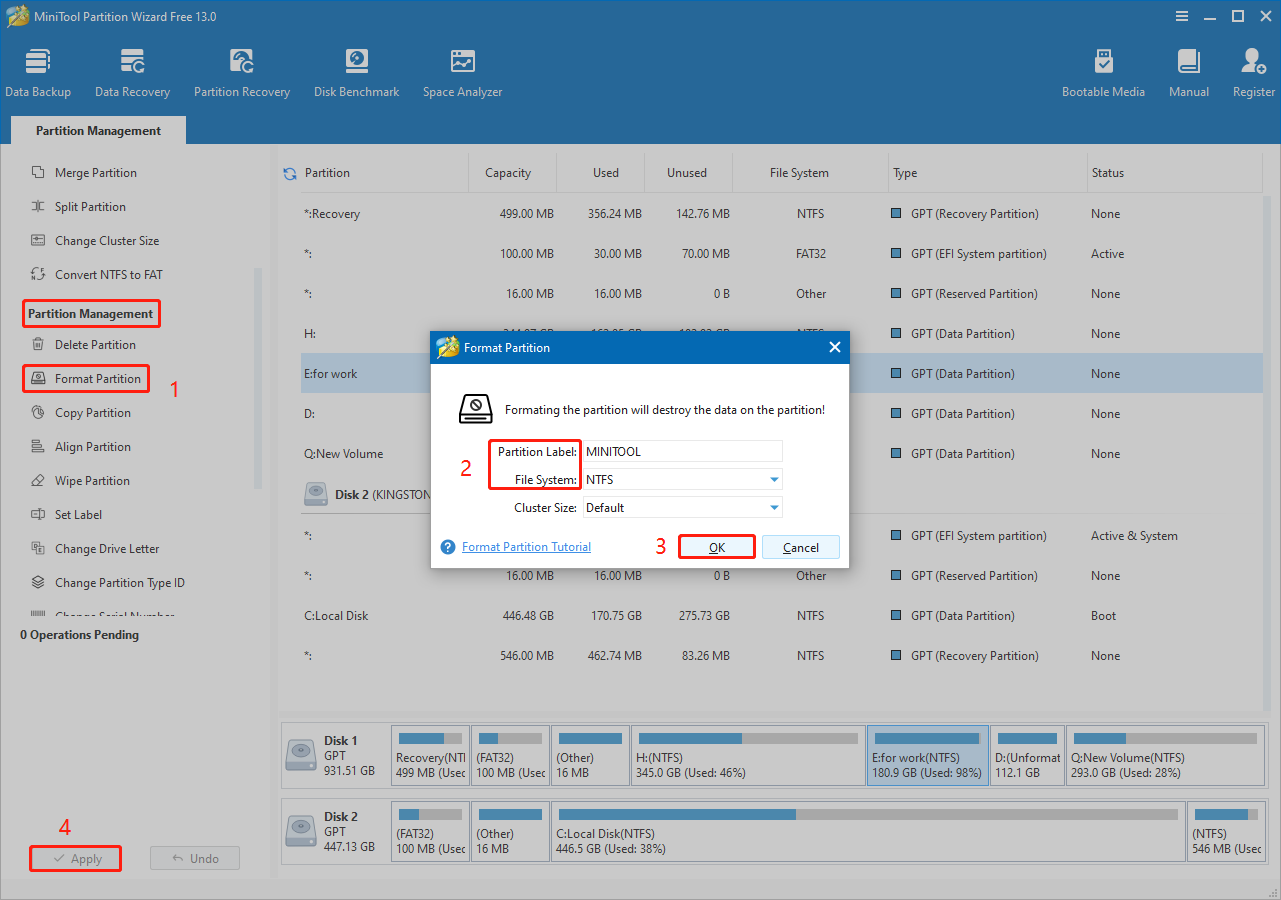
Common Reasons for “Parameter Is Incorrect”
After fixing this error, here are some causes of the “The parameter is incorrect” error and tips on how to protect your disk.
1. Poor USB port contact or a damaged data cable.
Aging or poor-quality data cables or loose USB connectors can cause unstable signal transmission. This prevents the system from properly identifying the drive and potentially triggering the parameter error.
Prevention: Use a high-quality data cable, prioritize connecting to the USB port on the back of the motherboard, and regularly clean the connector to maintain good contact.
2. Incompatible or outdated drivers.
When drivers are incompatible or outdated, errors can occur in the communication between the system and the hardware, leading to an incorrect parameter error.
Prevention: Regularly check and update disk-related drivers to ensure they are compatible with the current operating system version, and avoid using unverified third-party drivers.
3. File system corruption.
When Windows accesses a storage device, it relies on the device’s file system to read and write data. If the file system is abnormal, the “The parameter is incorrect” error may occur.
Prevention: To prevent file system corruption, avoid disconnecting drives abruptly, do not interrupt ongoing read/write operations, and ensure the disk is not running out of free space.
4. Virus infection.
Malicious software or viruses can sometimes cause damage to the file system, triggering the “parameter incorrect” error.
Prevention: Install reliable antivirus software and keep the virus definitions updated, and perform regular full system scans. Preventing malicious programs from damaging the file system is especially important when connecting external devices to the computer.
To Sum Up
This post teaches you how to fix the parameter is incorrect by running CHKDSK, updating disk drivers, running an SFC scan, or formatting the disk.
Most importantly, you need to recover data from your disk first using MiniTool Power Data Recovery. This keeps your files safe and prevents potential data loss during repairs.
Should you have any inquiries regarding MiniTool products, do not hesitate to reach out through [email protected]. We are here to assist you.


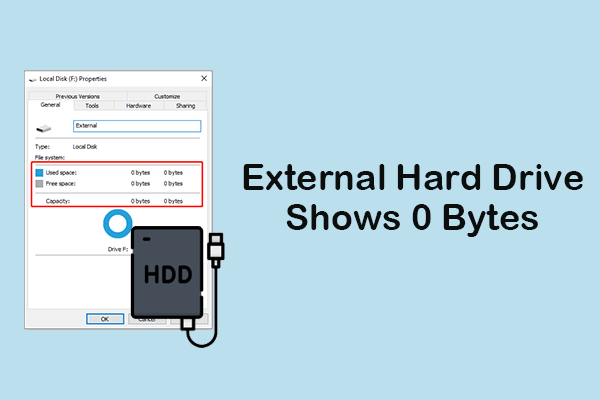

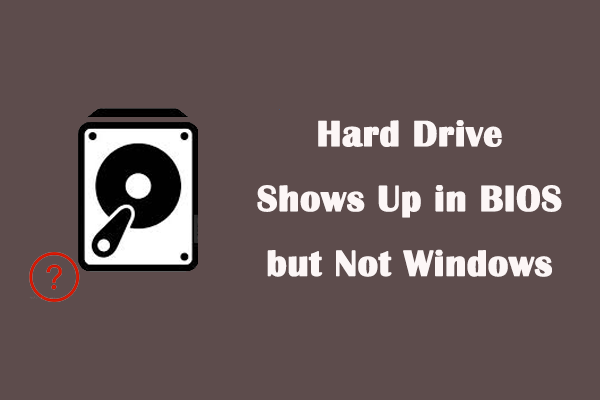
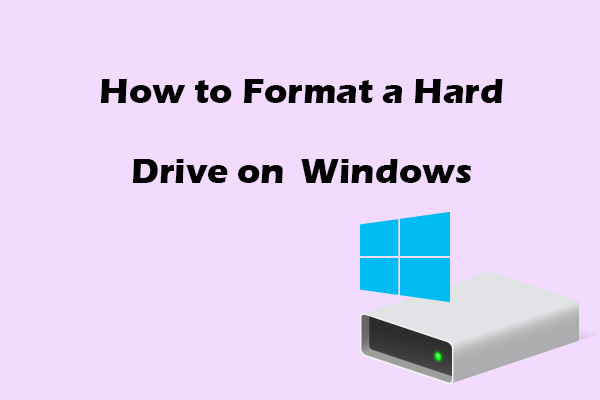
User Comments :